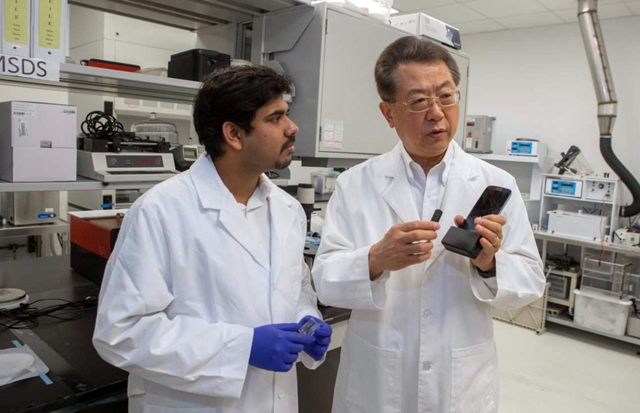
Chong Ahn, right, and doctoral candidate Sthitodhi Ghosh with their smartphone diagnostic system (Joseph Fuqua, Univ. of Cincinnati)
7 Feb. 2020. A university engineering lab designed a simple, inexpensive point-of-care device, powered by a smartphone, to detect infectious and other diseases. Researchers at University of Cincinnati in Ohio described their system and test results late last month in the journal Microsystems and Nanoengineering.
A team from the lab of Cincinnati electrical engineering professor Chong Ahn is seeking a reliable and easy-to-use device for point-of-care diagnostics, particularly for infectious diseases in low-resource regions. While microfluidic, or lab-on-a-chip systems are making progress in shrinking the size of testing platforms, in most cases they still require analysis in separate labs, usually some distance from the patients. And while mobile networks and cloud computing can connect remote locations, they require reliable, secure, and high-speed connections.
Doctoral candidate and first author Sthitodhi Ghosh led the project to design a simple, reliable, inexpensive, and self-contained microfluidic system for detecting disease at the point of care. Ghosh, Ahn, and colleagues started by designing a single-use disposable detection chip made from cyclic oelfin copolymer, a common biocompatible plastic material used in pharmaceutical packaging, as well as disposable diagnostic devices. In this chip, the team etched ultra-fine channels that employ capillary action to capture an individual’s saliva and move the fluid into tiny wells for analysis.
The chip also has optical sensors to record illuminating chemicals that react to suspected biomarkers, or molecular indicators of disease. The research engineers designed the device with freeze-dried antibodies and reagents applied to the chip, which liquefy when mixed with a person’s saliva. If a suspected biomarker is present in the saliva, the freeze-dried antibodies and reagents give off light, captured by the sensors.
“The innovation of this device is using a capillary-driven microfluidic lab chip,” says Ghosh in a university statement. “So the entire test takes place on the chip automatically. You don’t have to do anything.”
Those captured light waves are translated into electrical signals and sent to a smartphone through a USB port for analysis. The smartphone is a key requirement for the system, providing power for the chip, transfer path for the data, and software app to analyze the signals and display the results.
To prove the concept, the researchers tested the chip-smartphone system with a protein biomarker for malaria, Plasmodium falciparum histidine rich protein 2, or PfHRP2, unique to malaria and associated with severe forms of the disease. Tests by the team show the system can detect minute concentrations of PfHRP2 in specimen samples, with results returned within 20 minutes.
“The performance is comparable to laboratory tests. The cost is cheaper. And it’s user-friendly,” notes Ahn. “We wanted to make it simple so anyone could use it without training or support.”
The researchers believe their system is an easy-to-use and inexpensive platform to screen for infectious diseases, but can be extended to other disorders, particularly mental disease, where biomarker detection can replace subjective or self-reported symptoms. In addition, widespread use of this technology would enable researchers to amass large volumes of real-world data to help develop more evidence-based treatments.
University of Cincinnati applied for a patent on this technology. In 2004, Ahn founded the company Siloam Biosciences to take his lab’s discoveries to market. The company was acquired in 2018 by Korean diagnostic systems enterprise Mico Biomed, which took part in the study.
More from Science & Enterprise:
- Artificial Pancreas System Cleared by FDA
- Ingested X-Ray Capsule Shown Safe, Feasible
- Human Tooth Tissue Modeled in Chip Device
- Device Offers Real-Time Monitoring of Swallowing Problems
- Wearable Sensor Analyzes Sweat, Measures Chemicals
* * *

 RSS - Posts
RSS - Posts
[…] Smartphone Saliva Test Detects Infectious Diseases […]